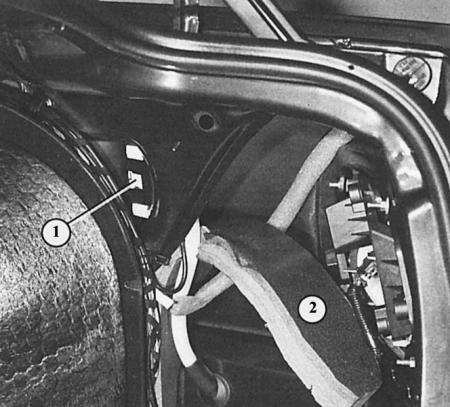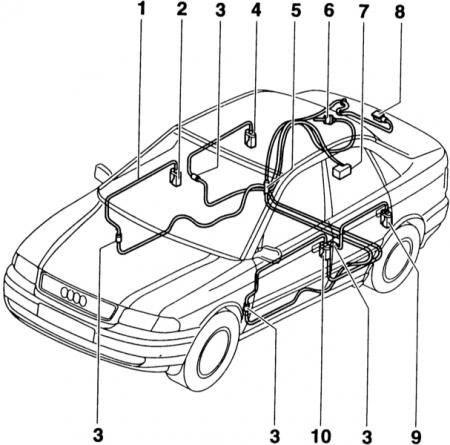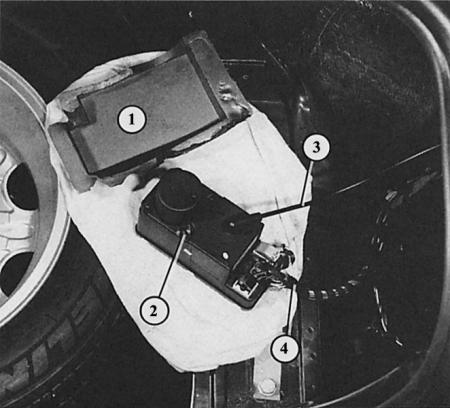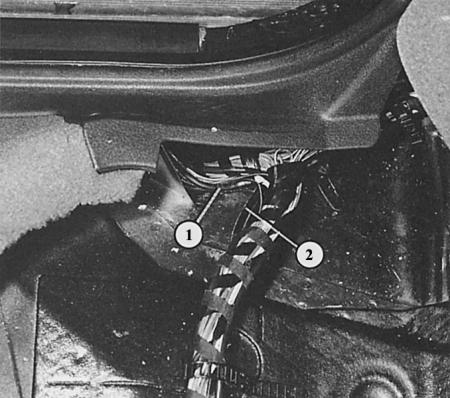
Emergency release of the fuel tank cap in the event of a central locking failure: remove the luggage compartment lining on the right, fold out the insulating plate (2), press the fixing latch (1) the central locking servomotor and pull the actuator back.
All doors, the trunk lid and fuel tank lid, and the lock in the trunk lid are opened and closed by turning the key in the driver's door lock or in the passenger's door lock next to the driver. The main link of the system is the so-called double pressure pump, which is driven by an electric motor. When the key is turned to position «open» the pump creates an increased pressure, as a result of which various switching elements in the vehicle release the existing blockage.
The central locking control unit is combined with the double pressure pump, as well as the control unit for the anti-theft system, if installed in the vehicle.
The following describes the serial central locking. Functions of more expensive systems with anti-theft installations, interior monitoring, infrared remote control (see also chapter Electrical equipment) in their main function are also based on this system, as are «central security lock».
Tip: Special feature of the trunk lock: in the vertical position of the trunk lock - regardless of the central locking - it is always closed. This prevents nimble thieves from opening the trunk when stopped at a traffic light. In the horizontal position, the trunk lock reacts to the central locking completely normally.
Checking the central lock
1. Close the driver's and passenger's door or trunk lid and open with the key.
2. The central lock must be activated from all three locks.
3. After about two seconds, all locks should be locked.
4. If the pump runs for more than five seconds, the system is leaking - in this case, the dual pressure pump can run for a maximum of 35 seconds, after which it should turn off.
Tip: If one day the central locking fails, the doors and boot lid can be opened and closed as usual with the key. Likewise, door lock buttons can be operated manually. Only the fuel filler cap needs to be unlocked separately: Remove the right boot liner. Press the fixing latch of the servomotor of the central lock of the fuel cap and pull the actuator back.
Electrical Troubleshooting
The description below also applies to vehicles with standard central locking. The electrical test is carried out at the 6- and 12-pin plug connector on the double charge pump. Vehicles with an anti-theft system have another 16-pin connector on the pump that is left unattended during testing.
If the pump does not work either when the key is turned in the lock of the driver's and passenger's door next to the driver, or in the trunk lock, then:
1. Check the fuse.
2. Remove the lining of the trunk at the rear and on the right side; the dual pressure pump is on the bottom right near the bottom of the boot and is packaged in foam.
3. «Unpack» double pressure pump.
Important: first disconnect the multi-pin connector from the pump (s) connector (s) with thin wires - at the end of the connector with a thick wire (current supply).
4. Remove the shell of the 12-pin connector
5. Checking the switching element in the driver's door: connect a test lamp to the connector between the green/blue wire contact and body ground.
6. The control lamp should burn constantly if the driver's door opens a key. In this case, the break contact is OK.
7. If the lamp does not light up, then the opening contact in the driver's door is faulty or there is no conductivity in the supply wire.
8. Switch the test lamp: instead of ground, one of the contacts of the test lamp is connected to «+» battery. The other pin remains connected to the connector (green/blue wire contact).
9. Close the driver's door with the key.
10. If the control lamp now lights up permanently, then the NO contact of the switching element is OK.
11. If the lamp does not light up and there is no defect in the wire, then the switching element is faulty.
12. Checking the switching element in the passenger door next to the driver: in the disconnected pump connector, connect a test lamp between the yellow / blue wire contact and body ground.
13. The control lamp should burn constantly if the passenger door next to the driver is opened with a key. In this case, the opening contact of the switching element is OK.
14. If the lamp does not light up, then the opening contact in the passenger door next to the driver is faulty or there is no conductivity in the supply wire.
15. Switch the test lamp: instead of ground, one of the contacts of the test lamp is connected to «+» battery. The other pin remains connected to the connector (yellow/blue wire contact).
16. Close the passenger door next to the driver with the key.
17. If the control lamp now lights up permanently, then the NO contact of the switching element is OK.
18. If the lamp does not light up and there is no defect in the wire, then the switching element is faulty.
19. Checking the switching element in the trunk lock: in the disconnected pump connector, connect a test lamp between the blue / red wire contact and «+» battery.
20. The control lamp should burn constantly if the luggage carrier lock opens a key. In this case, the opening contact of the switching element is OK.
21. If the lamp does not light up, then the opening contact in the trunk lock is faulty or there is no conductivity in the supply wire.
22. Switch the test lamp: instead of the blue / red wire, now one of the test lamp contacts is connected to the gray / white wire. The other contact remains connected to «+» battery.
23. Close the trunk lock with the key.
24. If the control lamp is on constantly while the key remains in the «closed», then the NO contact of the switching element is OK.
25. If the lamp does not light up and there is no defect in the wire, then the switching element is faulty.
26. Checking the double pressure pump: if the operation of the switching elements of the pump is guaranteed (verified), then the cause of the malfunction is only the supply of current (thin red wire in a 12-pin connector, and thick red/blue wire or thin red/black wire in a small 6-pin connector) and ground connection (thick brown wire).
27. If everything is in order, then the dual pressure pump is faulty. Replace.
Here you can see the details of laying the central locking hose

- 1 - hose;
- 2 - switching element of the passenger door next to the driver;
- 3 - connecting piece;
- 4 - switching element of the door on the right rear;
- 5 - detail of the outlet under the rear seat;
- 6 - switching element of the door of the fuel tank cover;
- 7 - double pressure pump;
- 8 - switching element of the trunk lid;
- 9 - switching element of the door on the left rear;
- 10 - switching element of the driver's door.

Double pressure pump (2) The central lock is installed under the right luggage compartment lining. Here he is «taken out» from its styrofoam shell (1). Next you see: electrical wires (4) and pressure/vacuum hose (3) to the switching elements.

Under the rear seat, the central pressure/vacuum hose branches into a harness to the right doors (1) and on the harness to the left doors (2).
Troubleshooting in the pneumatic system
1. To check for leaks in the central lock (Symptom: Dual charge pump running too long) you need to check the whole system one by one.
2. Double pressure pump: directly at the pump, squeeze the hose with pliers and close it tightly. Activate one of the locks.
3. If the double pressure pump runs longer than 3 when the central locking is activated, max. 7 s., then the pump is leaking. Replace it.
4. Switching elements in doors and lids: one by one, pinch all hoses directly next to the switching elements. To do this, dismantle the corresponding covers (chapter Body parts). Each time activate one of the locks.
5. The double pressure pump, when the central lock is activated, should not work longer than 3, max. 7 s.
6. After detaching the defective (leaky) pump assembly is operating normally, i.e. less than 3 s. Replace defective part.
Tip: In order not to dismantle the entire lining when disconnecting the hoses, you can pinch the hoses at the outlet - first the harness to the right doors, then to the left doors.

Visitor comments